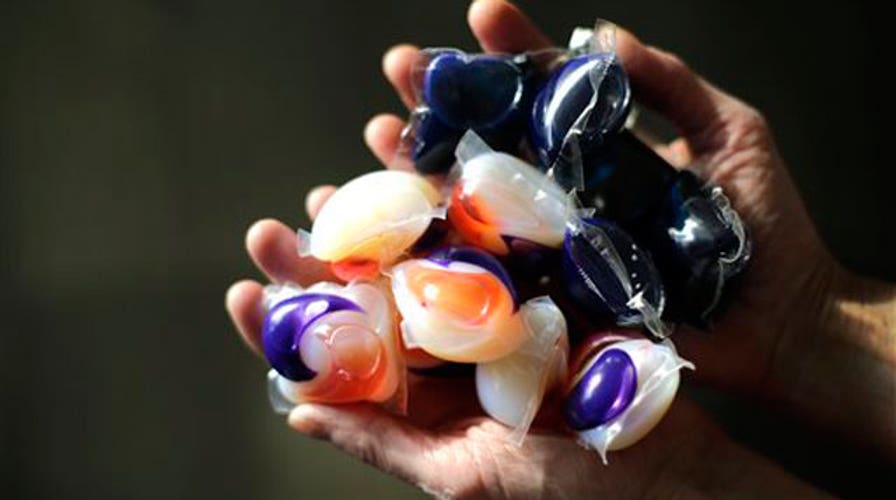Laundry pods, those colorful packets that can be easily tossed into the washing machine, aren’t just convenient, they’re dangerous for young children— sending one a day to the hospital.
New research conducted by researchers at Nationwide Children’s Hospital in Columbus, Ohio, found that from 2012 through 2013, U.S. poison control centers received reports of 17,230 children younger than age 6 swallowing, inhaling or being exposed to chemicals in laundry detergent pods. Nearly two-thirds of the cases involved 1 and 2 year olds. A total of 769 young children had to be hospitalized, an average of one per day.
“If I were a kid, I’d like to pick it up and play with it … it looks like it was made for young children to have fun with,” study co-author Dr. Marcel J. Casavant, chief of toxicology at Nationwide Children’s Hospital and medical director of the Central Ohio Poison Center, told FoxNews.com.
The study found that effects of consuming laundry pods included: vomiting (48 percent of cases), coughing and choking (13 percent), eye pain or irritation (11 percent), drowsiness or lethargy (7 percent), mouth pain, burning, difficulty breathing, and windpipe injuries. While vomiting is a symptom with traditional liquids and powders, typically it happens once or twice and that’s the end of it, Casavant noted. With the pods, side effects are significantly worse.
A number of children had to be admitted to intensive care and intubated, while a handful fell into a coma. Others showed a “significant altered mental state” and had trouble staying awake, Casavant said.
Researchers saw some cases where children were on breathing machines for several days. One child died.
“Compared to a lot of other injuries that poison control deals with, many of these are severe and certainly long lasting,” Casavant said.
According to Casavant, both the packaging and the formulations of laundry pods are likely causing these more severe reactions that lead to an average of one child per day being hospitalized.
“[When] a child gets into powders or liquids, they might want to take a taste of it, [and] get some accidentally on their fingers, and decide to clean their finger by popping it in their mouth,” he said. “Usually it’s a very, very, very small dose. In our experience, a child gets into a pod, gets the full dose, [and] can’t control how much gets into the mouth.”
Plus, ingredients may be highly concentrated in the pods, and some solvents from the plastic shrink wrap may be contributing to side effects like sleepiness, central nervous system depression, and coma.
To avoid exposure, Casavant recommended that people who have young children in their homes simply refrain from using laundry pods. If you do have them in your home, he said, keep them out of sight somewhere the kids can’t reach them.
However, Casavant noted that most exposures actually happen while the product is in use, not when a child has broken into the laundry room without supervision. Exposure commonly occurs when a parent is doing laundry and puts the pod next to the washer, or when the family is in the car to go to the laundromat and the pod is placed on top of the basket.
“Part of safe storage is to remember it’s a very, very dangerous time when you get the product out of storage and are starting to use it,” Casavant said.
Researchers recommend manufacturers take away the characteristics that make laundry pods appealing to children— that they’re bright, colorful and squishy. Plus, the bags that pods come in should not be see-through, so children aren’t tempted to open them.
Manufacturers may also consider using less-toxic ingredients. When looking at the laundry pod ingredients, researchers were unsure what was causing the toxicity.
“When we look at the list of chemicals given, it’s hard to imagine [or] understand why many of these kids are going into coma, having trouble staying awake … we don’t understand which chemicals are doing that,” Casavant said. “It’s hard to understand why we see burns from these— something is going on, maybe it’s ingredients they aren’t disclosing, maybe it’s the different ways the chemicals are working together in the laundry science to attack stains, inadvertently attacking children.”
As for the safety of items that are washed with laundry pods, Casavant said that the ingredients should be diluted quickly in the wash cycle, flushed down and then diluted further in the rinse cycle, so there shouldn’t be a significant concentration after someone finishes a load of laundry.
If your child is exposed to a laundry pod, or anything poisonous, call poison control immediately at 1-800-222-1222; the number is the same across the U.S. You’ll be connected with a nurse , physician, pharmacist or poison information provider who will give an individualized assessment and the best action to take in the situation. According to Casavant, poison control tries to keep children at home, though some are sent to the hospital if it’s appropriate.
“Rather than trying to have parents make decisions on their own, using information on the internet, it’s best to call poison control,” he said. “There will be some cases where we do need to call 9-1-1, but poison control is really good at making the decision with the caller in the first seconds.”

